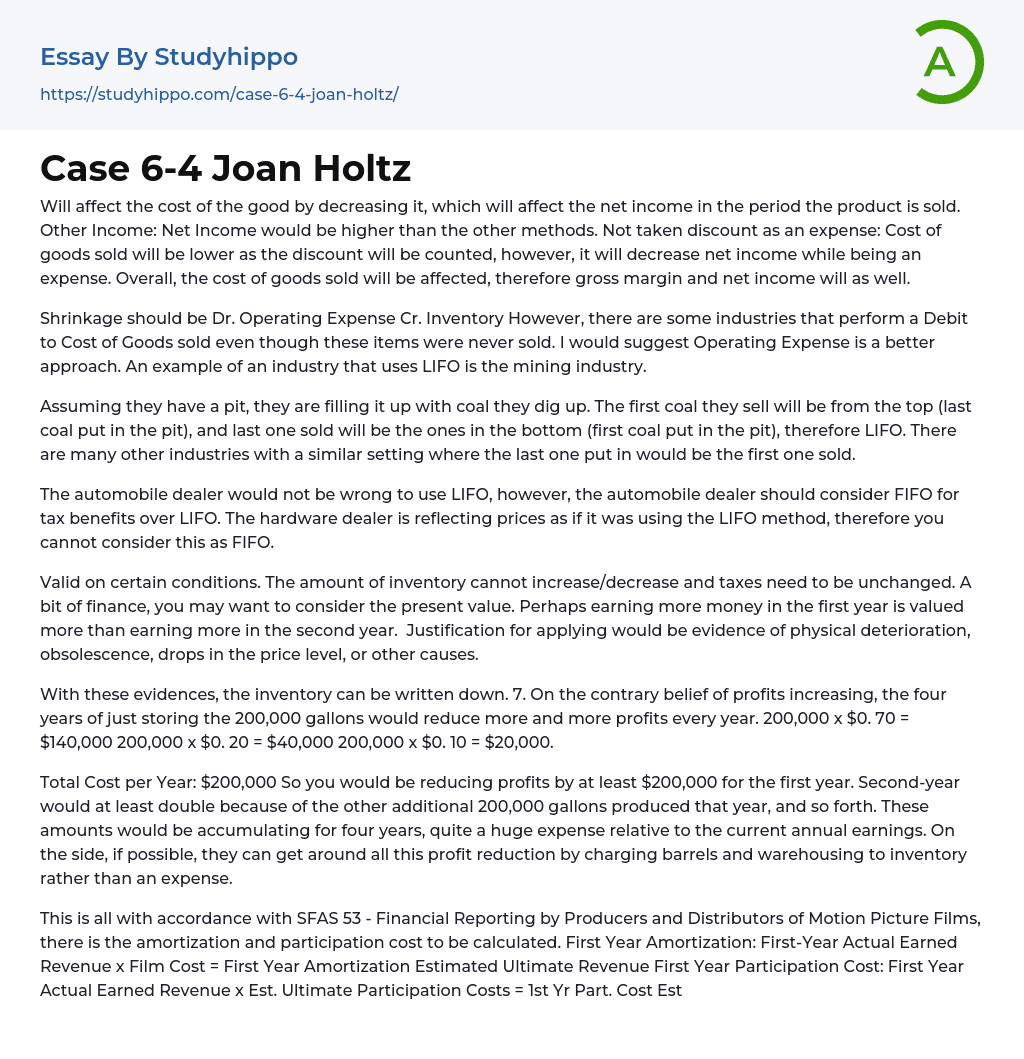Will affect the cost of the good by decreasing it, which will affect the net income in the period the product is sold. Other Income: Net Income would be higher than the other methods. Not taken discount as an expense: Cost of goods sold will be lower as the discount will be counted, however, it will decrease net income while being an expense. Overall, the cost of goods sold will be affected, therefore gross margin and net income will as well.
Shrinkage should be Dr. Operating Expense Cr. Inventory However, there are some industries that perform a Debit to Cost of Goods sold even though these items were never sold. I would suggest Operating Expense is a better approach. An example of an industry that uses LIFO is the mining industry.
Assuming they have a pit, they a
...re filling it up with coal they dig up. The first coal they sell will be from the top (last coal put in the pit), and last one sold will be the ones in the bottom (first coal put in the pit), therefore LIFO. There are many other industries with a similar setting where the last one put in would be the first one sold.
The automobile dealer would not be wrong to use LIFO, however, the automobile dealer should consider FIFO for tax benefits over LIFO. The hardware dealer is reflecting prices as if it was using the LIFO method, therefore you cannot consider this as FIFO.
Valid on certain conditions. The amount of inventory cannot increase/decrease and taxes need to be unchanged. A bit of finance, you may want to consider the present value. Perhaps earning more money in th
first year is valued more than earning more in the second year. Justification for applying would be evidence of physical deterioration, obsolescence, drops in the price level, or other causes.
With these evidences, the inventory can be written down. 7. On the contrary belief of profits increasing, the four years of just storing the 200,000 gallons would reduce more and more profits every year. 200,000 x $0. 70 = $140,000 200,000 x $0. 20 = $40,000 200,000 x $0. 10 = $20,000.
Total Cost per Year: $200,000 So you would be reducing profits by at least $200,000 for the first year. Second-year would at least double because of the other additional 200,000 gallons produced that year, and so forth. These amounts would be accumulating for four years, quite a huge expense relative to the current annual earnings. On the side, if possible, they can get around all this profit reduction by charging barrels and warehousing to inventory rather than an expense.
This is all with accordance with SFAS 53 - Financial Reporting by Producers and Distributors of Motion Picture Films, there is the amortization and participation cost to be calculated. First Year Amortization: First-Year Actual Earned Revenue x Film Cost = First Year Amortization Estimated Ultimate Revenue First Year Participation Cost: First Year Actual Earned Revenue x Est. Ultimate Participation Costs = 1st Yr Part. Cost Estimated Ultimate Revenue A proper estimation needs to be made to calculate any of these formulas, which cannot be made with the information given. However, this would be the idea to calculate the cost of sales for the first year. They should update the estimate of ultimate revenue and participation cost at
each reporting date.
If the producing company agreed to pay $100,000 for advertising and promoting the initial showing, this would all go into the expense in accordance with SOP 93-7, none can be capitalized. So it would not change the answer mentioned above. *This was taken from the New York State Society of CPAs, the date of the implementation of this policy was in the year 2001. I couldn’t find the Canadian, IFRS, or a more recent article regarding financial accounting of film costs. This answer can be completely wrong as many changes could have happened up to now.
- Accounts Receivable essays
- Auditor's Report essays
- Balance Sheet essays
- Costs essays
- Financial Audit essays
- International Financial Reporting Standards essays
- Tax essays
- Accountability essays
- Cash essays
- Principal essays
- Management Accounting essays
- Internal Control essays
- Accounting Software essays
- Cash Flow essays
- Net Present Value essays
- Income Statement essays
- The price essays
- Accounting essays
- Andrew Carnegie essays
- Automation essays
- Business Cycle essays
- Business Intelligence essays
- Business Model essays
- Business Operations essays
- Business Software essays
- Cooperation essays
- Cooperative essays
- Corporate Social Responsibility essays
- Corporation essays
- Customer Relationship Management essays
- Family Business essays
- Franchising essays
- Harvard Business School essays
- Harvard university essays
- Human Resource Management essays
- Infrastructure essays
- Inventory essays
- Logistics essays
- Management essays
- Manufacturing essays
- Market essays
- Marketing essays
- Multinational Corporation essays
- News Media essays
- Online Shopping essays
- Quality Assurance essays
- Richard Branson essays
- Sales essays
- Selling essays
- Shopping Mall essays




